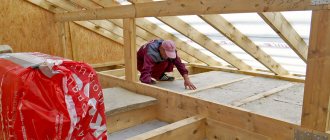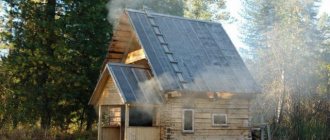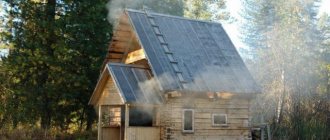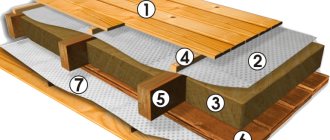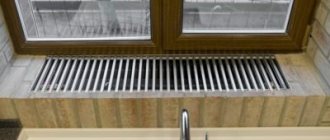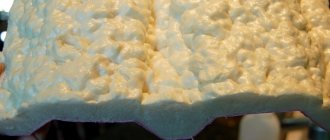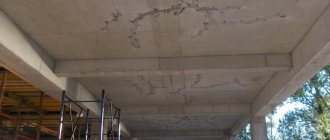We present to you a translation of an article written by the US Pulp Insulation Association,
as technical literature on vapor barrier when using cellulose insulation.
The organization has been in business for over 30 years and produces cellulose insulation and mulch for hydroseeding
. Located in Belchertown, Massachusetts USA. Serving insulation installers in all six New England states, New York and Long Island, Rochester, New Jersey, eastern Pennsylvania, Delaware and Maryland.
Original text of the article:
Translation using Google Translator:
Insulation of cellulose insulation from moisture and steam
Cellulose is the only insulating medium that truly regulates moisture.
Humidity depends on two transport mechanisms: air movement and diffusion. However, air movement is more significant, accounting for more than 98% of the total volume, and is the main cause of moisture problems. When cellulose insulation is blown or sprayed into a cavity at densities greater than 65kg/m3, the cellulose prevents wind-generated air movement, moisture condensation and building defects (shrinkage).
By inhibiting the movement of moist air, cellulose reduces moisture movement to acceptable levels for the building structure
. Any remaining moisture moved by diffusion will be further blocked by the primers and paints used in interior finishing.
In our northeastern climate, a vapor barrier is not only unnecessary, but may also be contraindicated, especially in air-conditioned buildings during the summer months when warm, moist air passes through wall structures and condenses on the outside of the cold poly-vapor barrier.
The hygroscopic nature of cellulose insulation gives the property of distributing moisture from higher to lower areas of concentration, which prevents damage from moisture accumulation, provided the path is not blocked by a vapor barrier.
Over the course of the year, most vapor-permeable walls in the Northeast will tend to dry out on the outside, while in the summer the same wall will dry out on the inside. NuWool brand cellulose insulation contains borates to resist mold growth, even when exposed to favorable conditions.
Since the 1970s, tens of thousands of homes have been built using cellulose insulation, the absence of vapor barriers and no signs of mold or structural damage are a testament to its effectiveness. Sophisticated moisture modeling by Mark E. Kelley III, PE, demonstrates that cellulose-insulated building assemblies without a vapor barrier exhibit faster drying and lower overall moisture levels than similar assemblies with a vapor barrier installed.
Therefore, we do not recommend the use of cellulose insulated vapor barriers except in environments with exceptionally high humidity levels, such as an indoor pool, and we guarantee our cellulose insulation for the life of the building when installed by a certified contractor.
Minvata
Mineral wool is one of the most popular insulation materials due to its relatively low cost and such qualities as low thermal conductivity (heat loss when using this material is reduced quite noticeably), ease of installation, and excellent sound insulation. In addition, mineral wool is not chewed by rodents; bacteria, mold, and fungi do not grow or multiply on it. Naturally, those who intend to insulate the walls of their home have a question: is a vapor barrier necessary when insulating with mineral wool?
Yes, I need it. A vapor-permeable membrane is used. It is laid with the vapor-permeable side on the prepared walls, and wooden slats are attached on top of it, to which the insulation will already be attached.
The membrane removes water vapor from the walls of the house through mineral wool. With this installation method, excess moisture is removed, the insulating material is not destroyed, and the walls of the house “breathe.”
Protection of frame wall insulation
A frame house with ecowool is also protected from moisture using various types of Izospan film:
— Izospan A, AM, Izospan A membranes with fire protection are mounted on the outside. Their task is to protect the insulation from moisture and allow steam to pass from inside the premises to the outside;
— hydro-vapor barrier films IzospanV, C, D are installed from the inside of the wall. They are designed to protect ecowool from waterlogging by vapors in the atmosphere of residential premises. The requirements for external and internal protection are similar to the general requirements for vapor barriers.
The insulation of ventilated facades is protected according to the general scheme with Izospan A films with fire protection.
Use of other insulation materials
Despite all the noticeable advantages of mineral wool, other insulating materials are often used. For example, ecowool is a fairly new material in our country (it has become widespread only in the last decade, although it has been used in the USA since the 70s of the last century). How does this material differ from mineral wool and is vapor barrier necessary when insulating with ecowool?
Ecowool consists of fluffed cellulose fibers that absorb moisture from warm air, however, the air between the fibers remains dry. Unlike mineral wool, it can withstand a change in humidity of 24% and still retain its insulating properties.
Let's consider another popular insulation material - expanded polystyrene, or simply polystyrene foam. They can insulate a room both outside and inside.
When performing external insulation, there is no particular point in using a vapor barrier: the foam itself insulates it quite well. The only thing you have to do is to maintain the correct technology for attaching polystyrene foam, depending on what material, breathable or not, your structure is made of.
If the vapor barrier is done well, warm air will not reach the walls, and therefore there will be no risk of getting wet. It is also necessary to ensure good ventilation of the room.
The video below explains in detail why vapor barrier walls are needed. An example of a thermal engineering calculator is given, showing the effect of the arrangement of wall layers on the dew point and thermal insulation.
We hope that you have sorted out your issues. We will be grateful if you share the material on social networks. The buttons for this are below.
Introductory part
The use of ecological cellulose wool as a heat-insulating building material in the conditions of the Western Siberian region requires a thorough study of the hygroscopic qualities. At the moment, there is no information about the technical characteristics of ecowool as a natural insulation that absorbs moisture at low positive and negative temperatures in Siberia. In this regard, it is necessary to fill the missing knowledge about the above-mentioned hygroscopic properties of recycled cellulose wool containing borax and boric acid as additional components.
Vapor barrier and ecowool - is it possible to do this?
I've been reading this wonderful forum for a long time, I learned a lot of useful things for my construction, for which I thank everyone very much!
I'm going to insulate the attic roof, the project specifies basalt wool, but I'm very interested in ecowool. There is one BUT - the builders put a non-vapor-transparent film of isospan D under the metal tiles. The design looks like this: - metal tiles - sheathing - 50x50 block - film - 150mm rafters
If you blow ecowool between the rafters to the entire height of 150 mm, will it not get wet due to condensation? If you still do a vapor barrier on the side of the room, it certainly won’t get wet, but then it turns out that the rafters will be sealed between two non-vapor-transparent films, which is also bad - they can rot without ventilation?
- Registration: Dec 2008
- Posts: 156
Answer: Vapor barrier and ecowool - is it possible to do this?
researcher added 01/27/2009 at 09:14
I've been reading this wonderful forum for a long time, I learned a lot of useful things for my construction, for which I thank everyone very much!
I'm going to insulate the attic roof, the project specifies basalt wool, but I'm very interested in ecowool. There is one BUT - the builders put a non-vapor-transparent film of isospan D under the metal tiles. The design looks like this: - metal tiles - sheathing - 50x50 block - film - 150mm rafters
If you blow ecowool between the rafters to the entire height of 150 mm, will it not get wet due to condensation?
if you seal the inside with a vapor barrier, it won’t get wet.
ecowool, incl. includes boric acid and borax - this prevents wood from rotting.
but in your case (as in mine) there is this catch: blowing in ecowool is essentially stuffing it quite tightly throughout the entire volume of the cavity. blowing ecowool into the cavity between two films will cause all non-solid surfaces to bulge. those. the hydrofilms will stick out like big bellies. If from the inside you can form a solid surface with the help of a black ceiling, then on the outside it is more difficult - the belly can easily reach the ends of the roofing screws (surely the ends go right through the sheathing?) and - goodbye waterproofing along with insulation.
I haven’t figured out how best to do it yet. Actually, I see two options: 1 – attach plywood sheets adjusted to size to the rafters under the external hydrofilm from the inside (however, during blowing, some of the cotton wool will be blown into the inevitable cracks, but in general the issue will be resolved) and this is quite expensive and hemorrhoidal. 2 – still install basalt. 3 – fill according to method AS06
those. Don’t blow it out, just pour it in without pressure.
The 3rd one doesn’t suit me because... I still need effective insulation - the area will be residential.[/quote]
Protection of insulation on floors
1. Basement floors.
On the basement side, Izospan C, D films are attached, laid without gaps, tears or cracks, with mandatory insulation of the seams with Izospan FL, SL sealant tapes.
On the side of the room, Izospan B film is laid, which performs the task of protecting the insulation from leaks, as well as from accidental tightening of the insulation by the stream of air sucked by the vacuum cleaner through the cracks between the floor boards.
2. Interfloor ceilings.
Hydro-vapor barrier films in interfloor ceilings protect the insulation from external damage and serve as protection against possible leaks from the upper floor. Izospan V vapor barrier film is used on both sides of the structure. The only requirement for the structure is to maintain a gap between the protective material and Ecowool.
3. Attic floors
On the attic side, protection from the Izospan A membrane is installed, which prevents water from flowing through the cracks and technological openings of the roof during precipitation. It is necessary to maintain a strictly controlled gap between the insulation and the protective layer.
Bottom vapor thermal insulation is made from Izospan B, C, D films. They protect Ecowool from fumes rising from living quarters. The requirements for the vapor barrier are similar to those for all protective films: no gaps, tears and insulation of seams between the panels using adhesive tape.
A comment
- Registration: Jun 2008
- Posts: 2037
Answer: Vapor barrier and ecowool - is it possible to do this?
I read somewhere on the Internet that to avoid bellies they use a semi-wet blowing method. ". and we make the ceilings and the attic on site (already during the installation process) - this is where we often use the semi-wet method (first we make a wet surface (with a spray nozzle mod. 349 - see the description at the previous link), and then we supply the raw materials )". As far as I remember, the idea is this: they stretch a polymer mesh (2x2 or 3x3 mm mesh) onto the rafters, wet it, blow in low-density ecowool, the next day a dense crust of dried ecowool will form on the mesh, and bring the backing density to the desired level. One of the practitioners posted a photo. I don’t remember what site I saw this on, sorry.
Regarding the films: on the bottom there is paraisolation (i.e. ordinary PE or PP film, preferably metalized on the bottom side), on the top there is wind protection (i.e. vapor-proof).
Types of materials according to vapor permeability:
To help builders correctly apply vapor barriers, various building materials are classified according to their vapor permeability.
Impermeable materials:
- Glass
- Sheet metal
- Polyethylene sheet
- Rubber membrane
- Vapor barrier paints
- Exterior plywood
- Foil Rigid Insulation Board
Semi-permeable materials:
- Foamed or extruded polystyrene
- Laminated plywood
- Bitumen coated paper
- Drywall painted with oil- or moisture-resistant latex paint
Waterproofing
- Waterproofing protects the walls of the house from the destructive effects of moisture, mildew, and mold.
- It is strengthened between the insulating material and the siding.
- Installation of the waterproofing membrane is carried out by overlapping the fabric by 10-15 cm.
- The canvases are stapled to the surface of the sheathing, and the joints are sealed with special tapes.
- Ventilation gaps are formed using lathing with a 25×50 block;
- A protective metal mesh is installed below

In conclusion, it is worth saying that insulating the walls of a house made of timber can be done independently. All that is required is your patience and some expenses, which will more than pay off in the future.
Laying ecowool using a garden vacuum cleaner
The advantage of this method is its low cost and ease of implementation. There is only one drawback - you will need an assistant, since you cannot do it yourself. Using a garden vacuum cleaner, you can insulate both the floor and walls, but only with dry ecowool. The wet method will require special equipment.
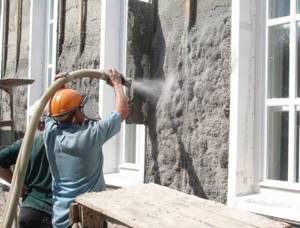
So, first you need to make a blow molding machine:
- Any garden vacuum cleaner can be used. It is better to choose reliable brands, but without a built-in chopper. The cheapest models break quickly - they are enough for 12-15 cubic meters of insulation. The built-in shredder greatly reduces the density of ecowool.
- Buy a flexible corrugated hose with a diameter of about 60-70 mm and a length of 7-10 meters. The diameter must be selected to match the outlet pipe on the vacuum cleaner itself - the hose must fit tightly.
- The waste collection bag is removed and the corrugation is put on the pipe. To make it more convenient, you can use pliers to bite out the teeth that secure the bag. The corrugation is secured with ordinary tape or tape so that there are no air leaks at the connection point. A running vacuum cleaner creates a strong air pressure, so you need to secure the corrugation as securely as possible.

That's it, the blow molding machine is ready. The process of floor insulation is practically no different from the manual method:
- in a tall barrel, ecowool is broken up with a construction mixer - there is no need to increase the volume much;
- the vacuum cleaner nozzle is lowered into the insulation;
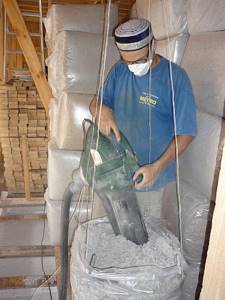
the second assistant holds the end of the corrugated hose as close to the floor as possible - this reduces the amount of dust that inevitably forms when blowing ecowool; the vacuum cleaner turns on and begins filling the floor cells with insulation.
If you first cover the floor with boards, leaving only one loose board for each cell, and insert the corrugation into the resulting hole, you can minimize the amount of dust.

You can also first pour a “mountain” of insulation, trying not to stir it up, and only then level it.
Insulating walls with a vacuum cleaner also requires two workers:
- the walls are completely lined with OSB;
- at a distance of 10 cm from the ceiling, holes are made to match the diameter of the corrugated pipe - two holes per OSB sheet;
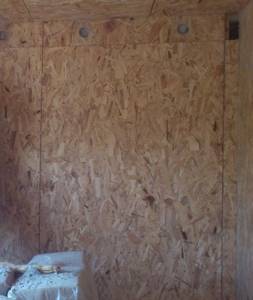
the corrugated hose is inserted into the hole and lowered down so that there are 30 centimeters to the floor; the filling of the wall begins as soon as the suction sound changes, which means that the ecowool layer has reached the outlet and you need to raise the hose another 30 cm; you can make several holes and more accurately control the filling of the wall.
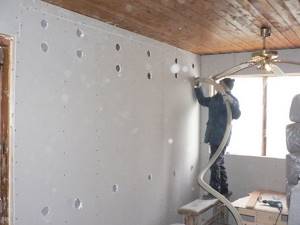
The holes in the walls are closed with the OSB circles remaining after cutting. This is easy to do by first nailing the circles to pieces of oilcloth, and after the edges of the oilcloth - to the walls.
The attic roof is also insulated in the same way. To simplify the process, it can be “blown out” in layers, starting from the bottom and ending at the crown. The description of the homemade machine and the process of insulating the attic is presented in detail in the video:
